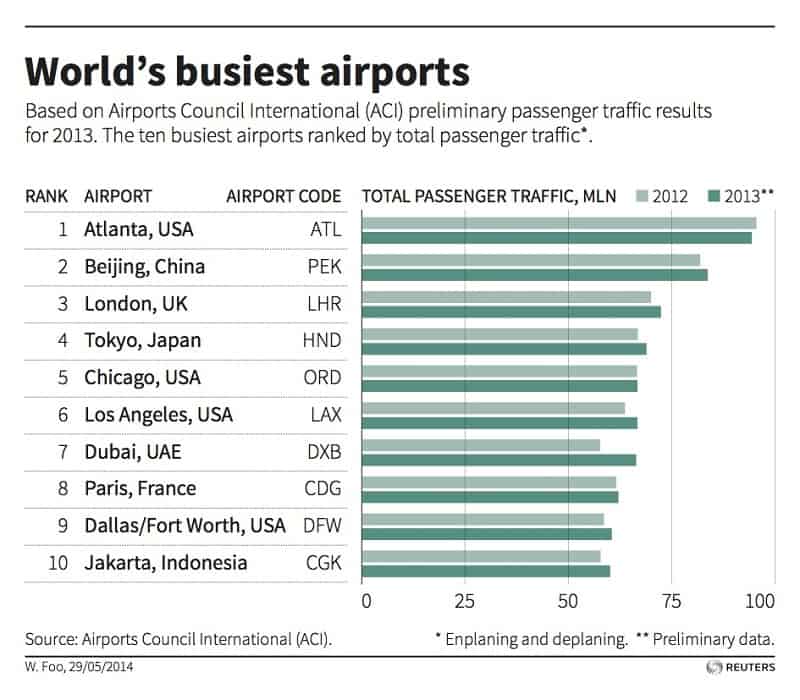
- Population: 9,912,167
- Capital City: Atlanta
- Demonym: Georgian
- State Bird: The Brown Thrasher
- Area: 59,441 square miles
- Highest Point: Brasstown Bald (4,784 feet above sea level)
- Industries: Textiles, timber and agriculture
- Abbreviation: GA
- Largest city: Atlanta
- Major River: Chattahoochee Rivero
- History: Georgia Was Founded as a Colony in 1733 by James Oglethorpe
- History: Georgia Has 159 Counties – More than Any Other State East of the Mississippi
- Nature: The State Has Its Own Distinctive Flower – The Cherokee Rose
- Industry: Georgia’s Pine Forests Produce 50% of the World’s Resin
- History: The State Was One of the First to Vote Against the Ratification of the 19th Amendment
- History: Martin Luther King Formed the Southern Christian Leadership Conference in Georgia in 1957
- History: Atlanta Was the Only City in North America to be Totally Destroyed as an Act of War
- Attractions: Georgia can Claim to Have the World’s Busiest Airport
- Geography: The Capital City, Atlanta, Has 55 Streets with the Same Name
- History: Georgia Experienced a Race Riot in 1906
- Georgia Is Home to the World’s Second Largest Indoor Aquarium
- Georgia’s Capital City, Atlanta, Has Had 2 Different Names
- Georgia Has 3 Very Strange Laws Which Have Never Been Overturned!
- Georgia Is the Largest Producer of Peanuts in the USA
- The World’s Largest Sculpture Is Located in Georgia
Georgia Was Founded as a Colony in 1733 by James Oglethorpe

The first of our fascinating Georgia facts tells us about the history and founding of the state. Oglethorpe lived a remarkably long life by the standards of the time, getting to almost 90 years of age before his death in 1785. He led the first wave of colonists that first arrived in Savannah in 1733, having been granted a charter to found it by King George II in 1732. Over the next 10 years he spent most of his time in the newly established colony where he built a sound economy and helped with the region’s political development. He also sought to recruit people from England and Europe to settle there.
Georgia Has 159 Counties – More than Any Other State East of the Mississippi
The next of our Georgia facts tells us about its geography. The state has 159 counties and there are some interesting facts about them. Two of the counties within Georgia, unusually, have two names. They are Jeff Davis County (named after Jefferson Davis – the one and only President of the Confederate States of America) and Ben Hill County (named after Benjamin Harvey Hill, a US Confederate Senator).
The State Has Its Own Distinctive Flower – The Cherokee Rose

Georgia has its own unique and distinctive state flower, the Cherokee Rose Rose Laevigata. It was introduced to the southern United States in 1780 and it became naturalized then. Around this time, it was also given its English name. It has very delicate white petals and a subtle, yet distinctive, fragrance. The white petals are said to symbolize the tears of native Cherokee women. Along with being popular in Georgia, the flower is also widely found in Vietnam, Laos and Taiwan in Asia. Georgia is also noted for its cherry blossom, which forms the basis of a beautiful festival held in Macon every year, aptly named the Cherry Blossom Festival.
Georgia’s Pine Forests Produce 50% of the World’s Resin

The next of our Georgia facts tells us about its pine forests. Georgia, alongside another well-known state, Florida, is responsible for producing some of the most well preserved varieties of long-leaf pine in the entire world. The state’s pine forests have been burned down regularly though, to encourage the Bobwhite Quail to use the areas for its natural habitat. The resin that is created from the pine forests in Georgia makes up half of the entire world’s production and also goes towards producing half the world’s turpentine! A staggering 74% of this is used in America alone.
The State Was One of the First To Vote Against the Ratification of the 19th Amendment
The 19th Amendment was very important in terms of women’s rights, as it was the amendment that allowed women the chance to vote. Georgia, along with 10 other states, decided to go against this, however. Even when it did eventually become federal law in 1920, Georgia still did not grant women the right to vote until 1922. The state did not ratify the amendment in its entirety until 1970.
Martin Luther King Formed the Southern Christian Leadership Conference in Georgia in 1957
The next of our Georgia facts tells us about a very important moment in history for the state. In 1957 the Southern Christian Leadership Conference (SCLC) was formed here. This group was dedicated to finding non-violent ways of gaining equal rights for African-Americans. The group is still active today and was a major contributor to the civil rights movement. The SCLC was formed in Georgia’s capital city, Atlanta.
Atlanta Was the Only City in North America to be Totally Destroyed as an Act of War

Another one of our interesting historical Georgia facts relates to the Civil War. General William Sherman had Atlanta raised to the ground during the 1860s as part of his scorched earth policy during fighting against the confederate states. In total, only 400 buildings in the entire city survived. After this time, the city adopted the phoenix as its symbol because it rose from the ashes, and so did they city of Atlanta.
Georgia can Claim to Have the World’s Busiest Airport

The Hartsfield-Jackson International Airport in the capital city, Atlanta, genuinely is the world’s busiest airport, though it might not be the first name that springs to mind when we think of the planet’s major air hubs! The fact of the matter is that Atlanta is ideally placed within the USA for easy travel. Most major cities in the country are a simple three-hour flight from here. Possibly the most awesome fact about the airport is that in total it measures the same as 45 football fields!
The Capital City, Atlanta, Has 55 Streets with the Same Name
The next of our Georgia facts tells us a little about the geography of the capital city. Atlanta actually has 55 streets that share the same name: Peachtree Street. However, it would appear that none of them were actually named after a peach tree. It’s possible that the name is a corruption of the Native American village name of Standing Pitch Tree.
Georgia Experienced a Race Riot in 1906

This is probably one of Georgia’s darkest moments. Although the reasons for the race riot were never truly made clear, it is believed that in September 1906 state newspapers reported that men of color were attacking white women in Georgia. This caused anger amongst the white male population who gathered in the state’s capital Atlanta and went on a damaging rampage, causing injury and death to many people and destroying many locally owned family businesses. The riots were so severe that they made international headlines. They went on to influence the Passage of Prohibition in 1908.
Georgia Is Home to the World’s Second Largest Indoor Aquarium

The next of our fascinating Georgia facts tells us about its previously record breaking indoor aquarium. This large building holds eight million gallons of water in total and is home to 100,000 different animals and around 5,000 different species. Up until 2012, it was the world’s largest indoor aquarium. It was surpassed, however, by the Marine Life Park in Singapore. Businessman Bernard Marcus provided the bulk of the money to fund and build the venture in Georgia, wanting Atlanta to have one of the best aquariums in the world. There are some notable species living in the aquarium, including whale sharks, beluga whales and bottle-nosed dolphins.
Georgia’s Capital City, Atlanta, Has Had 2 Different Names
Originally, the capital city of the state was called Terminus and Marthasville, which is a bit of a mouthful! The latter half of this unusual name came about from Governor Wilson Lumpkin, who had wanted to name the capital, at least in part, after his daughter Martha. However, the city’s newer and slightly easier to remember name came about when a railroad engineer called J. Edgar Thompson christened it Atlanta-Pacifica. This name eventually became shortened to the simple Atlanta we are all familiar with today.
Georgia Has 3 Very Strange Laws Which Have Never Been Overturned!
- If you’re in the capital city, it is illegal to tie a giraffe to a telephone pole or street lamp. But not any other type of pole!
- If you visit Atlanta and you’re feeling peckish, you might fancy an ice cream. But beware! It is – bizarrely – illegal to keep an ice cream cone in your back pocket in Atlanta!
- If you ever visit the town of Gainsville and you decide you’d like some delicious fried chicken to eat, you’d better be prepared to eat it with your hands. Eating poultry cooked in this way with a fork was outlawed in 1961!
Georgia Is the Largest Producer of Peanuts in the USA
In 2012 alone, Georgia produced 730,000 acres of peanuts. This amounts to around $3.3billion in monetary terms! Georgia’s peanut production actually accounts for 49% of the country’s overall production of this foodstuff – even though it is actually native to South America. One of the most well-known former US Presidents, Jimmy Carter, came from a family who were responsible for peanut farming in the Georgia county of Sumter.
The World’s Largest Sculpture Is Located in Georgia

The last of our interesting Georgia facts tells us about this record breaking sculpture, which can be found on the face of Stone Mountain. On this monumental feature you will see the faces of Jefferson Davis, General Stonewall Jackson and Robert E Lee. Lee’s horse, Traveler, also features on the monument. The entire sculpture measures exactly three acres, is 400 feet off the ground and is recessed at 42 feet inside the actual mountain. A truly astonishing feat of engineering!
Georgia Facts – Facts about Georgia Summary
 Facts about Georgia tell us that the capital city, Atlanta, has the world’s busiest airport, and that it was previously named Terminus and Marthasville. Georgia produces 49% of the USA’s peanuts and also 50% of the world’s resin, which can then be turned into turpentine. The state was also one of the most important places in the civil rights movement, but suffered a major race riot in 1906.
Facts about Georgia tell us that the capital city, Atlanta, has the world’s busiest airport, and that it was previously named Terminus and Marthasville. Georgia produces 49% of the USA’s peanuts and also 50% of the world’s resin, which can then be turned into turpentine. The state was also one of the most important places in the civil rights movement, but suffered a major race riot in 1906.
Was this page helpful?
Our commitment to delivering trustworthy and engaging content is at the heart of what we do. Each fact on our site is contributed by real users like you, bringing a wealth of diverse insights and information. To ensure the highest standards of accuracy and reliability, our dedicated editors meticulously review each submission. This process guarantees that the facts we share are not only fascinating but also credible. Trust in our commitment to quality and authenticity as you explore and learn with us.


